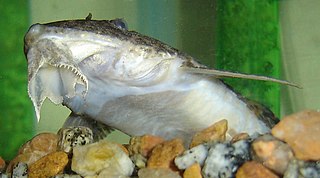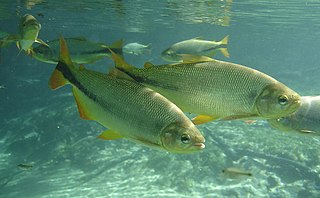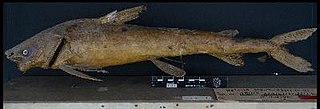
The Ariidae or ariid catfish are a family of catfish that mainly live in marine waters with many freshwater and brackish water species. They are found worldwide in tropical to warm temperate zones. The family includes about 143 species.

Rineloricaria is a genus of freshwater tropical catfish belonging to the family Loricariidae. They are commonly called whiptail catfish because of the long filament that grows out of the tip of the caudal fin that is characteristic of the genus. With the exception of R. altipinnis from Panama, they are native to the rivers of northern and central South America. Some species are regularly seen in the aquarium trade.

Astroblepus is a genus of fish in the family Astroblepidae found in South America and Panama. This genus is the only member of its family. These catfishes are primarily found in torrential streams in the Andean area. Astroblepus pholeter and A. riberae are troglobites adapted to living in subterranean water systems. These species are typically small, less than 10 cm (4 in). The largest species reaches 30 cm (1 ft). These fish have suckermouths like those of loricariids. They have two pairs of barbels, maxillary and nasal. The dorsal fin spine lacks a locking mechanism. These fish also have odontodes, tiny teeth on their skin. All species exhibit a conical, pointy type on their fin rays like that found in other loricarioids; other species also exhibit a blunt type that is only found on their skin.

Farlowella is a genus of fish in the family Loricariidae native to South America. This genus is broadly distributed in Amazon, Orinoco, Paraná and coastal rivers of the Guyana Shield. It is absent from the Pacific slope of the Andes and from the coastal rivers of the Brazilian Shield. Many of these species are kept in aquarium. This genus has a unique body shape that resembles of a thin stick of wood. The body is slender and elongate, often with a pronounced rostrum and a brownish color with two lateral dark stripes beginning at the tip of the rostrum, passing over the eyes and ending at the tail, which are periodically interrupted on the caudal peduncle.

Sturisoma is a genus of armored catfishes native to Central and South America.

Sturisomatichthys is a genus of armored catfishes native to Central and South America.

Brycon is a genus of fish in the family Characidae found in freshwater habitats in Central and South America, ranging from southern Mexico to northern Argentina. Despite not being closely related to true trout, they are sometimes called South American trout. Members of the genus may also be referred to as piraputanga. They reach a maximum length of 11.9–79.5 cm (4.7–31.3 in) depending on the species involved. Some species perform seasonal breeding migrations.

Pimelodella is a genus of three-barbeled catfishes.

Arius is a genus of catfishes of the family Ariidae. The genus Arius is distributed in brackish and fresh waters of Eastern Africa and south to Southeast Asia.
The Mapalé is an Afro-Colombian style of dance that was brought over by the slaves, and representing the fishermen after a long day of work. Its name comes from the Cathorops mapale (fish) when they are out of the water. The dance moves are compared with the agility and strength of those who are performing it. From the clothing to the precise moves of the hips and shoulders, the Mapalé is deemed to be very sexual. The body movements during the dance are swiftly made to follow the beating of the drums and represent the fish out of the water (men), while the women are the sea.

Potamarius is a genus of sea catfishes. The three species in this genus exclusively inhabit fresh water in southern Mexico and Guatemala. The individual species have relatively small ranges. The highly endangered Paragenidens grandoculis of Brazil was long classified in Potamarius, but a 2019 study has found it to belong in its own genus.

Chaetostoma also known as the Bristlemouths is a genus of suckermouth armored catfishes native to South America with one species C. fischeri extending into Panama. Most species inhabit flowing rivers in the lower Andes and its foothills. Some species are kept in unheated aquaria.

Notarius is a genus of fish in the family Ariidae found in the Atlantic and Pacific Ocean.

Arius manillensis is a species of marine catfish endemic to the island of Luzon, Philippines. It is commonly known as the Manila sea catfish or kanduli. It is fished commercially.

The Mapale sea catfish, is a species of sea catfish in the family Ariidae. It is a tropical fish which is known from Colombia to west Venezuela, where it typically inhabits freshwaters, brackish, in coastal lagoons and near-shore marine waters. It reaches a maximum standard length of 30.6 cm (12.0 in).
Cathorops festae is a species of sea catfish in the family Ariidae. It was described by George Albert Boulenger in 1898. It is known from Peru and Ecuador.
The Papillate sea catfish, also known as the Kailola's sea catfish, is a species of sea catfish in the family Ariidae. It was described by Alexandre Pires Marceniuk and Ricardo Betancur-Rodríguez in 2008. It is a tropical fresh and saltwater catfish which occurs in Central America. It reaches a standard length of 25.4 cm (10.0 in).

The Box sea catfish is a species of catfish in the family Ariidae. It was described by Albert Günther in 1864. It is a tropical, marine catfish which occurs in Guatemala, Costa Rica, El Salvador, Colombia, Peru, Ecuador, Mexico, Nicaragua, Honduras, and Panama. It dwells at a maximum depth of 20 m (66 ft). It reaches a 30 cm (12 in).
The Curator sea catfish, also known as the Raredon's sea catfish, is a species of catfish in the family Ariidae. It was described by Alexandre Pires Marceniuk, Ricardo Betancur-Rodríguez and Arturo Acero Pizarro in 2009. It is a tropical, marine and freshwater-dwelling fish which occurs between Mexico and El Salvador.
Chinchaysuyoa is a genus of catfishes in the family Ariidae. They are found in freshwater habitats along the Pacific Coast of northern South America. This genus was named after Chinchay Suyu, the Incan name for the region that these fishes are native to.















